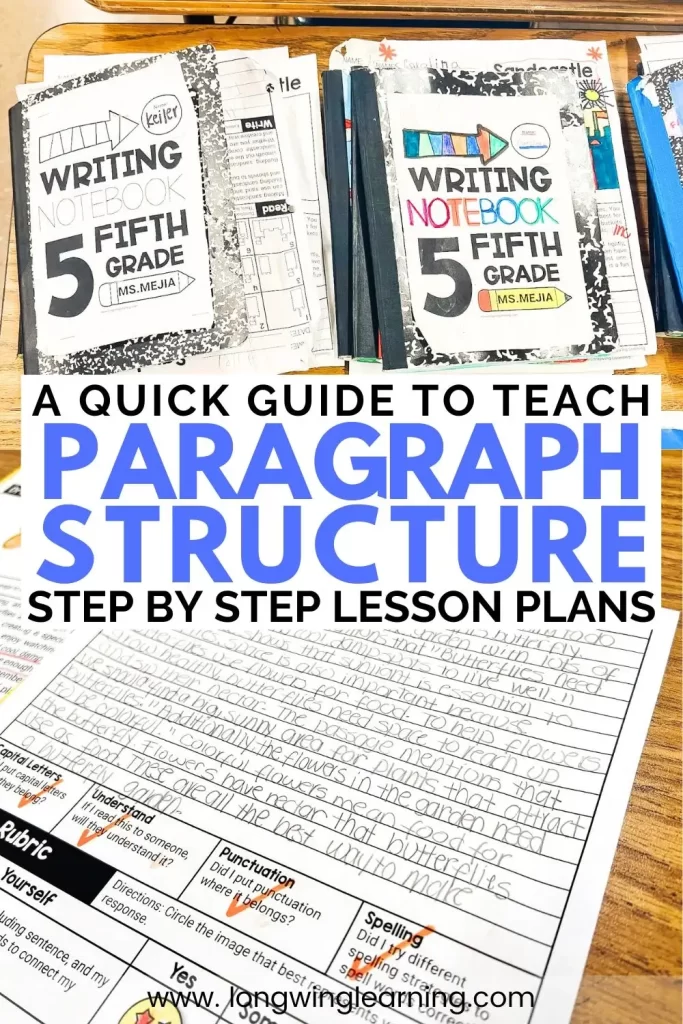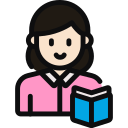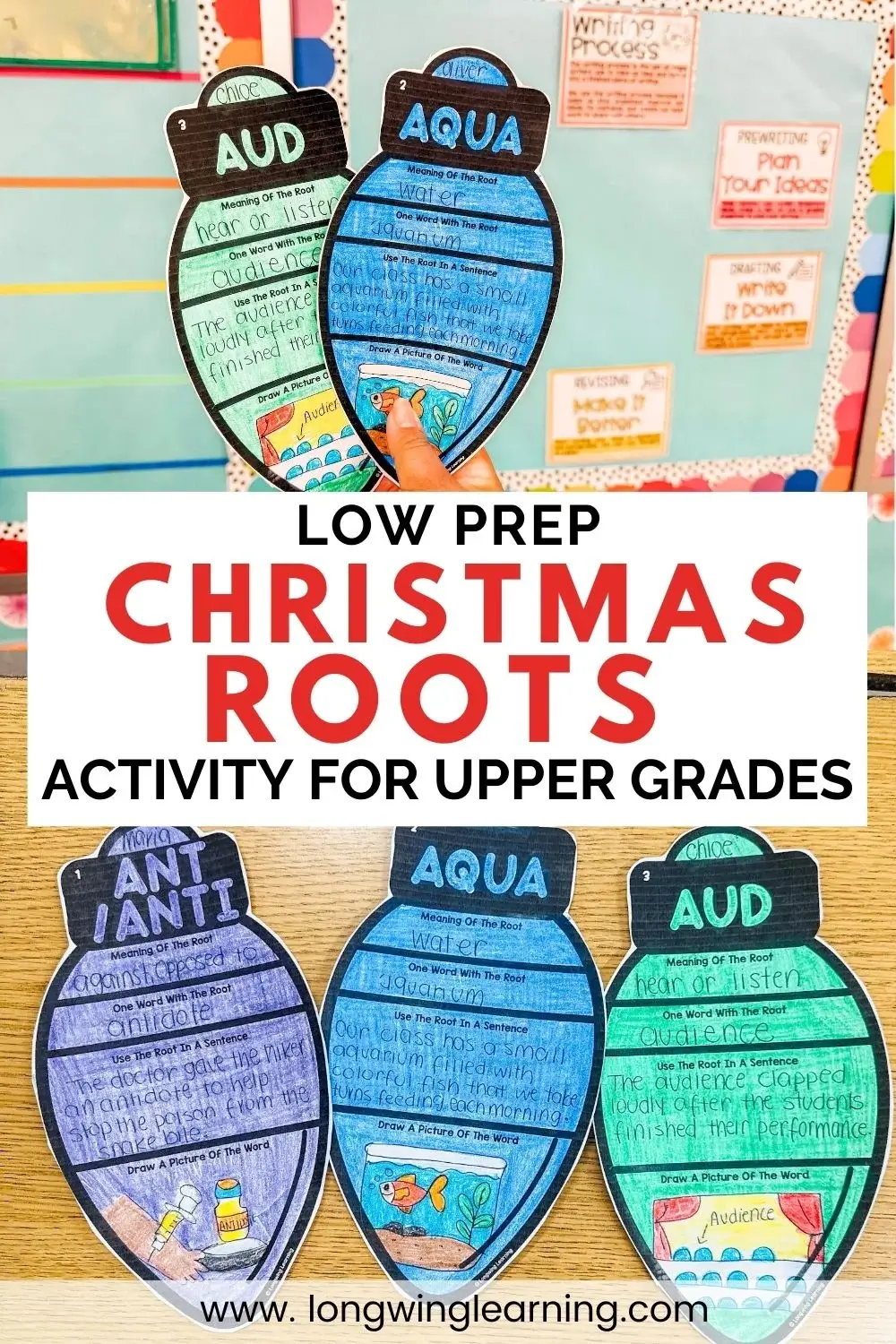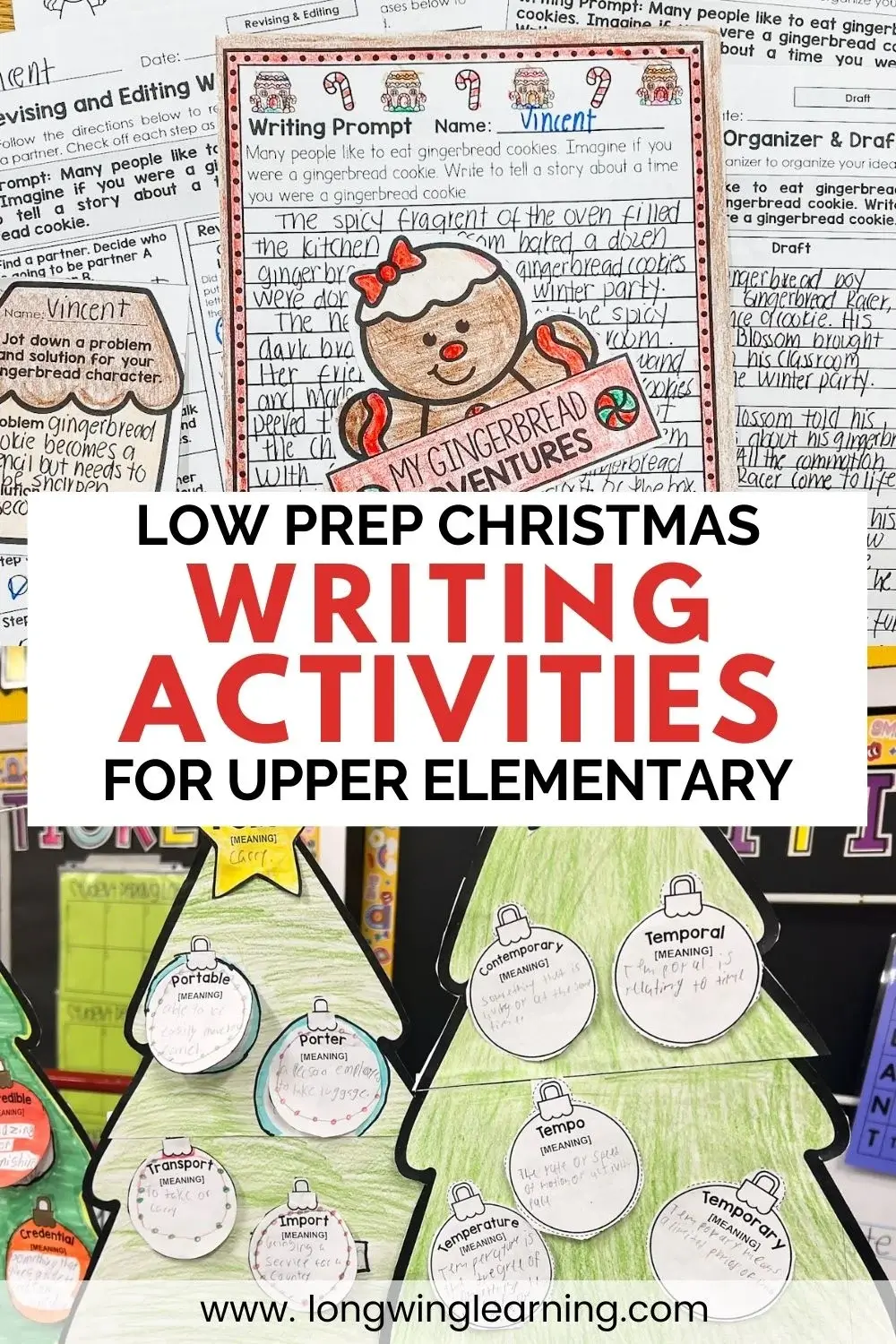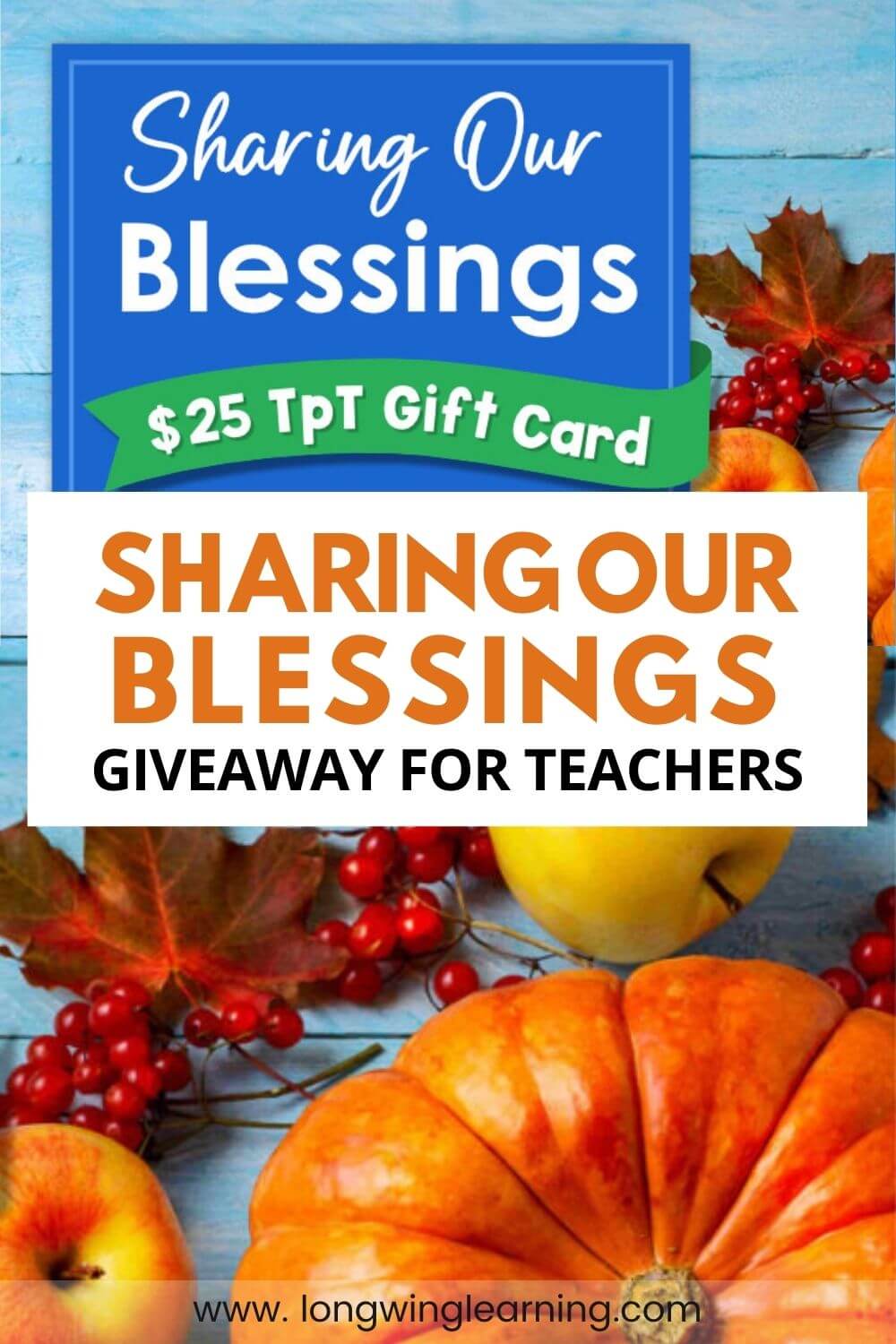Are your students struggling to write a well-written paragraph? Here’s a step-by-step plan to help them get there.
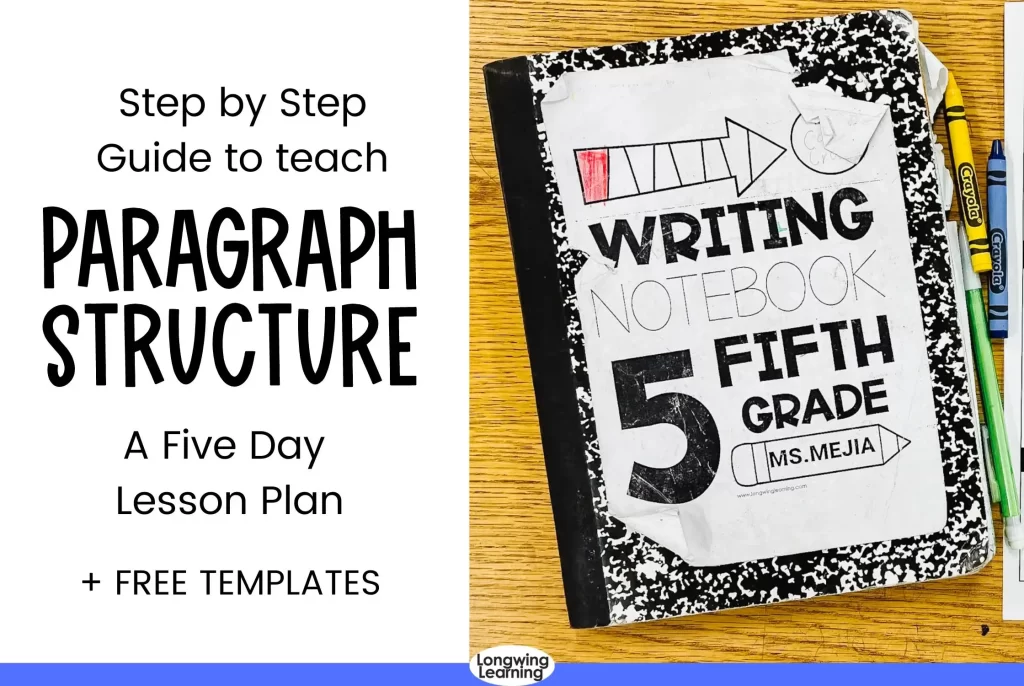
Upper elementary students need explicit writing instruction to help them organize their thoughts and connect their ideas into a single paragraph.
By teaching them how to write strong topic sentences, use transition words, and develop their ideas, we are laying the foundation for them to write good paragraphs.
This foundation makes it easier for them to succeed in academic writing tasks, from short constructed responses to writing essays.
As teachers, we all want to see our students succeed in writing, but sometimes it’s hard to know where to start.
As a fourth-grade teacher, I have seen students stare at a blank page, not knowing how to begin their paragraph until I broke down the writing process step-by-step on how to write a well-structured paragraph.
By the end of this post, you’ll have my five-day plan to teach paragraph writing, starting with sentence structure and progressing to a complete paragraph.
Let’s dive into the lesson plan and get ideas to implement this plan in your classroom.
Table of Contents
Understanding the Basics Parts of a Paragraph
A paragraph is a group of sentences that consists of three main parts: a topic sentence, supporting details, and a concluding sentence.
Let’s take a closer look at each basic part of a paragraph with examples by answering the writing prompt about why dogs are the best pets.
Topic Sentence
The topic sentence tells the main idea of the paragraph, focusing on a single topic.
It’s the first sentence and introduces what the paragraph will be about.
An example of a topic sentence for this prompt: “Dogs make excellent pets because they are loyal, friendly, and great companions.”
Supporting Details
The supporting details provide evidence, examples, and explanations to support the topic sentence.
They are found in the rest of the paragraph and make up the longest part of the paragraph.
Here is an example of supporting details for the prompt about dogs.
“Dogs are known for their loyalty. For example, they protect their owners and always show love. They keep us company and help us feel better when we’re stressed. You can teach dogs to fetch things or assist people with disabilities. Their fun and friendly behavior makes them great friends for kids and adults.”
Concluding Sentence
The concluding sentence is the last sentence and wraps up the paragraph by summarizing the main points or giving a final thought.
An example of a concluding sentence for this paragraph is: Therefore, with their loyalty and companionship, dogs make wonderful pets.
Building a Strong Foundation Before Writing Paragraphs
Before we jump into the lesson plan, here’s how I set the stage for teaching paragraph writing.
At the beginning of the year, I teach different sentence structures and then move on to the basics of writing a paragraph.
To make sure the topics we write about are interesting and relevant, I first ask my students to complete a survey about their favorite things and hobbies.
This way, I can pick topics they are excited about and already know a lot about, which keeps them engaged during the writing process.
Five-Day Lesson Plan for Teaching the Basic Parts of a Paragraph
Day 1: Introduction to Topic Sentences
On the first day, the focus is on introducing topic sentences. The goal is for students to grasp the purpose and structure of a topic sentence.
We start by identifying topic sentences in sample paragraphs, discussing why they work well, and how they set up the paragraph’s main idea.
To make this concrete, we’ll look through nonfiction passages from our reading books for topic sentences.
Students will copy these topic sentences into their writing notebooks, starting a collection we’ll later use to create sentence starters.
Also, I explain the difference between the terms we use when we read and write. In reading, we talk about the “main idea” or “central idea,” while in writing, we use the term “topic sentence.”
Even though they mean the same thing, using the correct term in each context helps clarify our focus.
The first time students practice writing their own topic sentences, they answer different writing prompts I come up with based on their survey answers about their favorite things.
You can assign this activity to be completed independently, but it’s always more fun and less intimidating when done in groups.
After that, we create a “Topic Sentence Wall” where students post their sentences on sticky notes on chart papers.
We finish by reading them aloud and having a class discussion.
Day 2: Developing Supporting Details
On Day 2, the goal is to help students understand and create supporting details.
We start by focusing on how supporting details make up the middle sentences of a paragraph, offering examples that back up the topic sentence.
I begin by showing students how to brainstorm using a graphic organizer, and we then list supporting details together.
For this exercise, we use the prompt about why dogs make the best pets to generate our supporting details.
Next, students will revisit a writing prompt from day one and use a graphic organizer to plan and write their supporting details.
Start this activity in groups and let students pick another prompt to work on independently.
Another idea is to give each group a different writing prompt from the day before. This way, everyone writes about different topics.
A great follow-up lesson is studying the different types of elaboration to develop their supporting details.
Read more about practical strategies for teaching elaboration and adding detail in this post.
Day 3: Writing Concluding Sentences
Day 3 focuses on writing the concluding sentence. The objective is to teach students how to summarize and conclude a paragraph.
First, I’ll explain that the concluding sentence wraps up the paragraph’s main idea.
I emphasize that the concluding sentence is a one-sentence summary of the topic sentence and supporting details.
To reinforce this, I use the following steps to model writing a concluding sentence:
First, we find the main idea: Dogs make excellent pets.
Next, we look for key details and underline one word that can summarize each sentence.
I emphasize focusing on the most important details without introducing any new information.
Here is an example:
- They are loyal and friendly.
- They protect their owners and show affection.
- They help people with disabilities.
Now, we put it all together in a shorter form: Dogs are great pets because they are loyal, friendly, and helpful.
Afterward, students will practice concluding sentences using the writing prompt they chose the day before.
I continue to pair them up in groups and then work independently.
Day 4: Drafting a Complete Paragraph
On Day 4, students will combine topic sentences, supporting details, and concluding sentences to create complete paragraphs.
They will use topics from their writing surveys, allowing them to write about their interests.
For hands-on practice, students are placed in groups and complete the “Pass the Paragraph” activity.
In this activity, each student writes a different part of the paragraph, either the topic sentence, supporting details, or the concluding sentence based on a topic they chose.
They then pass the paper to the next student, who continues writing until the paragraph includes all three basic parts.
The goal is for each paragraph to have a topic sentence, supporting details, and a concluding sentence without worrying about the length.
Another activity is to create paragraph parts on separate pieces of paper.
Then, students work in pairs or small groups to arrange the sentences correctly to form a complete paragraph.
Day 5: Revising and Polishing Paragraphs
On Day 5, the goal is to revise and edit paragraphs to make them clear and coherent.
Students work on improving the structure and flow through peer review.
Each student will swap their draft with a classmate, giving and receiving feedback on improving their writing.
To help with this, students will check if their classmate’s paragraph includes a clear topic sentence, supporting details give information about the topic of the paragraph, and if the concluding sentence ties everything together.
Here is a simple checklist to guide them through the process:
- Topic Sentence: Is it clear, and does it introduce the main idea?
- Supporting Details: Are they in a logical order? Do they support the topic sentence well?
- Concluding Sentence: Does it summarize the main points and provide a clear ending?
After teaching the basic parts of a paragraph, I expand on this foundation by using writing prompts with reading passages. This approach helps students learn to gather evidence and elaborate on it.
Meanwhile, they continue practicing writing new paragraphs using the various activities in the writing center.
These ongoing practices help reinforce their skills and build their confidence in writing.
Teaching Transitional Phrases & Words
I introduce transitional phrases and words to help students write well-structured paragraphs during the revision process.
I explain the purpose of transition words, emphasizing how they help guide the reader from one idea to the next.
We return to our supporting details and pick the best transition words to connect each sentence.
Here are two of my favorite activities to help students add transition words to improve their writing fluency.
1. Make a Transition Word Anchor Chart
Create an anchor chart with a list of common transition words and phrases. Include categories like:
- Addition: Furthermore, Moreover, In addition
- Contrast: However, On the other hand, Although
- Cause and Effect: Therefore, Because, Consequently
- Sequence: First, Next, Finally
2. Transition Word Practice Sentences
In this activity, I provide students with sentences that need transition words added.
We start by reading the supporting sentences and discussing the best words to connect them.
They can pick from the anchor chart or come up with new ones.
Digital Tools for Paragraph Writing
Technology is part of our writing practice since my students’ writing tests are online, and typing is crucial!
Once students grasp the basic parts of a paragraph, we transition to typing their paragraphs in Microsoft Word.
Typing the paragraph afterward helps them get comfortable typing and introduces them to useful tools and software features.
For their final draft, I incorporate the following activities.
1. Typing Practice
We start with typing exercises where students practice typing their sentences and paragraphs to build their typing speed and accuracy.
2. Formatting Basics
I teach students to use basic formatting tools in Microsoft Word, like bold, italics, and underlining, to highlight key parts of their paragraphs.
I love displaying these keyboard shortcut posters as they are helpful visuals throughout the year.
You can find these keyboard shortcuts inside our Computer Lab Rules Class Decor Pack.
3. Collaborative Editing
Students share their drafts with classmates using Google Docs or Microsoft Word. They practice giving and receiving feedback using comments and suggestions.
4. Spell Check and Grammar Tools
This part is tricky because my students must check their spelling and grammar on the testing platform without help from software tools. I turn off these features for writing assignments, but I turn them back on for projects.
Incorporating these activities has prepared them for their writing tests and builds confidence in their ability to create well-structured paragraphs.
Wrapping It Up
In this post, we looked at the basic parts of a paragraph: topic sentences, supporting details, and concluding sentences. I also shared my five-day lesson plan to teach these skills step-by-step.
Mastering these parts is essential for developing strong writing skills in upper elementary students.
Now that you have these tools, try implementing them in your classroom.
Download our free guide on teaching paragraph writing for additional tips and resources.
Don’t forget to save this guide for later! Pin the image to your Pinterest board so you can easily find it when you’re lesson planning.
